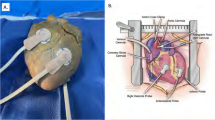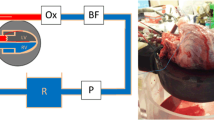Abstract
Effects of coronary vasodilator, dipyridamole, on epicardial oxygenation and flow were investigated under conditions of moderate coronary occlusion using near-infrared spectroscopic (NIRS) and thermal imaging. In anesthetized open chest pigs an inflatable occluder and flow probe were placed around the left anterior descending artery (LAD). In the ischemic group (n = 11) LAD occlusion (50% flow, 80 min) was followed by complete occlusion (10 min, n = 4), and reflow. Dipyridamole was infused (0.14 mg/min/kg/4 min) intravenously during 50% occlusion. In the control group (n = 6) LAD flow was temporarily increased (hyperemic response) by two 2-min periods of complete LAD occlusion applied 120 min apart, with a 4-min period of dipyridamole infusion between the two occlusions. NIRS and thermal images were acquired throughout the protocol. Maps of subepicardial oxygen saturation parameter (OSP), and epicardial temperature (T) were obtained. Partial occlusion reduced OSP and the temperature by 0.23 ± 0.08 and 0.88 ± 0.39°C versus remote region, respectively. Dipyridamole decreased systolic blood pressure by 36%, which caused further decline in the LAD flow to 18% and OSP and T by 0.37 ± 0.01 and 2.46 ± 0.32°C, respectively. Reflow restored OSP and T to their baseline levels. In control group dipyridamole and hyperemia increased LAD flow 2–4-fold associated with moderate increase in OSP and T. OSP and T showed linear dependence on the flow below 100%, which is leveled-off at flows above normal. Dipyridamole increases differences in the epicardial oxygenation and T between normal and moderately ischemic areas due to enhancement of disparity in perfusion of these areas.






Similar content being viewed by others
References
Nighswander-Rempel SP, Shaw RA, Mansfield JR et al (2002) Regional variations in myocardial tissue oxygenation mapped by near-infrared spectroscopic imaging. J Mol Cell Cardiol 34(9):1195–1203
Nighswander-Rempel SP, Shaw RA, Kupriyanov VV et al (2003) Mapping tissue oxygenation in the beating heart with near-infrared spectroscopic imaging. Vibrational Spectroscopy 32(1 SPEC.):85–94
Kupriyanov VV, Nighswander-Rempel S, Xiang B (2004) Mapping regional oxygenation and flow in pig hearts in vivo using near-infrared spectroscopic imaging. J Mol Cell Cardiol 37(5):947–957
Nighswander-Rempel SP, Kupriyanov VV, Shaw RA (2005) Relative contributions of hemoglobin and myoglobin to near-infrared spectroscopic images of cardiac tissue. Appl Spectrosc 59(2):190–193
Robicsek F, Masters TN, Svenson RH et al (1978) The application of thermography in the study of coronary blood flow. Surgery 84(6):858–864
Daniel W, Klein H, Hetzer R et al (1979) Thermocardiography-a method for continuous assessment of myocardial perfusion dynamics in the exposed animal and human heart. Thorac Cardiovasc Surg 27(1):51–57
Malm A, Arborelius M Jr, Lilja B et al (1979) Effects of nitroglycerin and dipyridamole on acute myocardial infarction: a thermographic study in the dog. Cardiovasc Res 13(5):281–287
Papp L, Allo G, Szabo Z et al (1985) Natural history of acute regional myocardial ischaemia revealed by infrared thermography in the canine heart. Acta Morphol Hung 33(1–2):123–142
Adachi H, Becker LC, Ambrosio G et al (1987) Assessment of myocardial blood flow by real-time infrared imaging. J Surg Res 43(1):94–102
Gordon N, Rispler S, Sideman S et al (1998) Thermographic imaging in the beating heart: a method for coronary flow estimation based on a heat transfer model. Med Eng Phys 20(6):443–451
Manley D, Nighswander-Rempel S, Xiang B et al (2004) Thermal Assessment of cardiac ischemia in vivo. J Mol Cell Cardiol 36:632
Gould KL (1978) Noninvasive assessment of coronary stenosis by myocardial perfusion imaging during pharmacologic coronary vasodilatation. I. Physiologic basis and experimental validation. Am J Cardiol 41:267–278
Iskandrian AS, Verani MS, Heo J (1994) Pharmacologic stress testing: mechanism of action, hemodynamic responses, and results in detection of coronary artery disease. J Nucl Cardiol 1(1):94–111
Robles HB, Lawson MA, Johnson LL (1994) Role of imaging in assessment of ischemic heart disease. Curr Opin Cardiol 9(4):435–447
Leppo JA (1996) Comparison of pharmacologic stress agents. J Nucl Cardiol 3(6 Pt 2):S22–S26
Schaper W, Lewi P, Flameng W et al (1973) Myocardial steal produced by coronary vasocilation in chronic coronary artery occlusion. Basic Res Cardiol 68(1):3–20
Marshall RJ, Parratt JR (1973) The effects of dipyridamole on blood flow and oxygen handling in the acutely ischaemic and normal canine myocardium. Br J Pharmacol 49(3):391–399
Cohen MV, Sonnenblick EH, Kirk ES (1976) Coronary steal: its role in detrimental effect of isoproterenol after acute coronary occlusion in dogs. Am J Cardiol 38(7):880–888
Becker LC (1978) Conditions for vasodilator-induced coronary steal in experimental myocardial ischemia. Circulation 57(6):1103–1110
Beller GA, Holzgrefe HH, Watson DD (1985) Intrinsic washout rates of thallium-201 in normal and ischemic myocardium after dipyridamole-induced vasodilation. Circulation 71(2):378–386
Manley D, Xiang B, Kupriyanov VV (2005) Coronary stealing by dipyridamole: evaluation of flow by thermal and optical imaging of pig hearts in vivo. J Mol Cell Cardiol 38:819
Kirk ES, Honig CR (1964) Nonuniform distribution of blood flow and gradients of oxygen tension within the heart. Am J Physiol 207:661–668
Moss AJ (1968) Intramyocardial oxygen tension. Cardiovasc Res 2(3):314–318
Winbury MM (1971) Redistribution of left ventricular blood flow produced by nitroglycerin. An example of integration of the macro- and microcirculation. Circ Res 28(Suppl):140–147
Barrett JA, Lynch VD, Balkon J et al (1986) Measurement of oxygen tension in the ischemic myocardium using encased polargraphic oxygen electrodes. J Pharmacol Methods 15(3):235–243
Weiss HR, Sinha AK (1978) Regional oxygen saturation of small arteries and veins in the canine myocardium. Circ Res 42(1):119–126
Holtz J, Grunewald WA, Manz R et al (1977) Intracapillary hemoglobin oxygen saturation and oxygen consumption in different layers of the left ventricular myocardium. Pflugers Arch 370(3):253–258
Parsons WJ, Rembert JC, Bauman RP et al (1993) Myocardial oxygenation in dogs during partial and complete coronary artery occlusion. Circ Res 73(3):458–464
Gonschior P, Gonschior GM, Conzen PF et al (1992) Myocardial oxygenation and transmural lactate metabolism during experimental acute coronary stenosis in pigs. Basic Res Cardiol 87(1):27–37
Schaper W, Binz K, Sass S et al (1987) Influence of collateral blood flow and of variations in MVO2 on tissue-ATP content in ischemic and infarcted myocardium. J Mol Cell Cardiol 19(1):19–37
Fedor JM, McIntosh DM, Rembert JC et al (1978) Coronary and transmural myocardial blood flow responses in awake domestic pigs. Am J Physiol 235(4):H435–H444
Fujiwara H, Ashraf M, Sato S et al (1982) Transmural cellular damage and blood flow distribution in early ischemia in pig hearts. Circ Res 51(6):683–693
Patterson RE, Kirk ES (1983) Analysis of coronary collateral structure, function, and ischemic border zones in pigs. Am J Physiol 244(1):H23–H31
Hearse DJ, Muller CA, Fukanami M et al (1986) Regional myocardial ischemia: characterization of temporal, transmural and lateral flow interfaces in the porcine heart. Can J Cardiol 2(1):48–61
Millard RW (1980) Changes in cardiac mechanics and coronary blood flow of regionally ischemic porcine myocardium induced by diltiazem. Chest 78(1 Suppl):193–199
Gerber BL, Bluemke DA, Chin BB et al (2002) Single-vessel coronary artery stenosis: myocardial perfusion imaging with Gadomer-17 first-pass MR imaging in a swine model of comparison with gadopentetate dimeglumine. Radiology 225(1):104–112
Segar DS, Ryan T, Sawada SG, Johnson M, Feigenbaum H (1995) Pharmacologically induced myocardial ischemia: a comparison of dobutamine and dipyridamole. J Am Soc Echocardiogr 8(1):9–14
Schafers KP, Spinks TJ, Camici PG et al (2002) Absolute quantification of myocardial blood flow with H(2)(15)O and 3-dimensional PET: an experimental validation. J Nucl Med 43(8):1031–1040
Neill WA, Levine HJ, Wagman RJ et al (1961) Left ventricular heat production measured by coronary flow and temperature gradient. J Appl Physiol 16:883–890
Reynolds EW Jr, Yu PN (1964) Transmyocardial temperature gradient in dog and man: Relation to the polarity of the T wave of the electrocardiogram. Circ Res 15:11–19
Manley DM, Xiang B, Kupriyanov VV (2007) Visualization and Grading of Regional Ischemia in Pigs in vivo Using Near-Infrared and Thermal Imaging. Can J Physiol Pharmacol (in press)
Author information
Authors and Affiliations
Corresponding author
Rights and permissions
About this article
Cite this article
Kupriyanov, V.V., Manley, D.M. & Xiang, B. Detection of moderate regional ischemia in pig hearts in vivo by near-infrared and thermal imaging: effects of dipyridamole. Int J Cardiovasc Imaging 24, 113–123 (2008). https://doi.org/10.1007/s10554-007-9222-z
Received:
Accepted:
Published:
Issue Date:
DOI: https://doi.org/10.1007/s10554-007-9222-z




